Welcome back to central campus
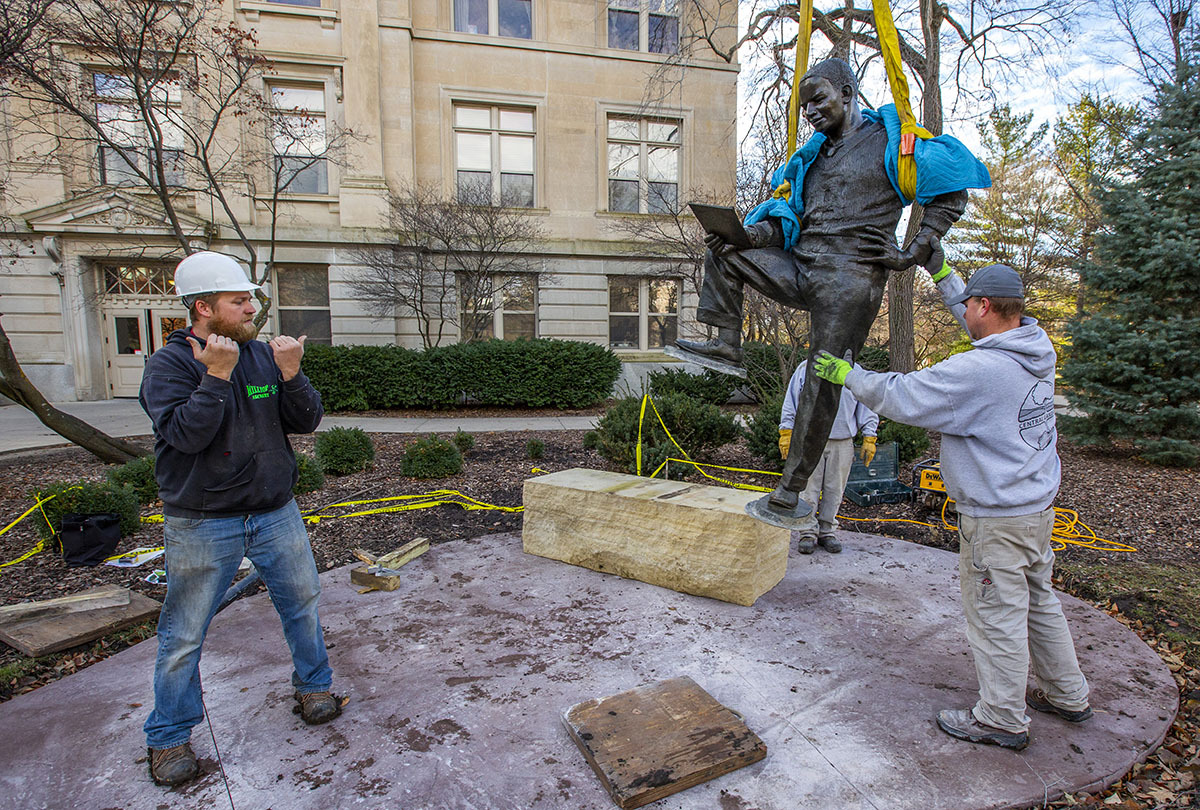
Zack Groomes, an equipment operator in facilities planning and management pictured left, guides the placement of the Jack Trice sculpture in its new central campus location. Photos by Christopher Gannon.
Dec. 5 reception
A public reception to mark the sculpture's return to central campus will be held Thursday, Dec. 5 (1-2:30 p.m.), in the ground floor atrium of Beardshear Hall. A short program featuring President Wendy Wintersteen, Student Government representatives and Cyclone student-athletes will begin at 1:30 p.m.
Pedestrians north of Beardshear Hall now are greeted by the bronze sculpture of Jack Trice. The artwork, installed during Thanksgiving break, was moved from its location near the football stadium that bears Trice's name to accommodate construction of a sports performance center and plaza.
In 1987, the Student Government commissioned the Christopher Bennett sculpture to honor Trice, Iowa State's first black athlete. He died from injuries sustained in his first collegiate football game -- a road contest at the University of Minnesota, Minneapolis, on Oct. 6, 1923.
The sculpture was located between Beardshear and Carver halls from 1988 to 1997, when it was moved to the north side of the stadium. At more than 6.5 feet tall, it features Trice looking at a letter of his thoughts written the night before the Minnesota game. The Trice sculpture now sits near the south edge of University Museums' Anderson Sculpture Garden.
Art conservators completed preservation work on the sculpture after it was removed from its stadium location last spring. A committee is working on an art installation at the stadium that will be dedicated to Trice's legacy.
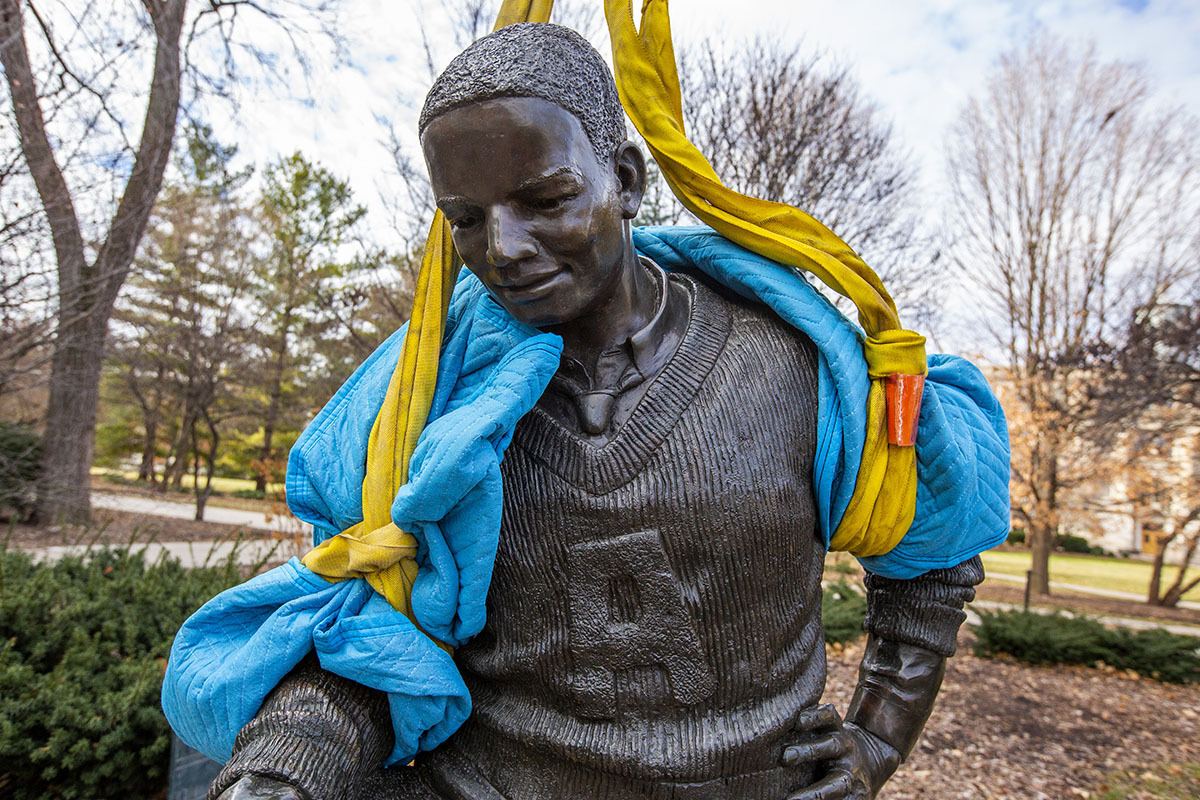
The bronze sculpture depicts Jack Trice reading a letter of his thoughts written the night before the 1923 football game at Minnesota.
Navigating gift policies in the season of gift-giving
Gift-giving in the workplace, while possible year-round, records an uptick as the winter holidays approach. The university's gift policy doesn't prohibit gift exchanges among co-workers. Grounded in Iowa law, it's intended to curtail outside donors who -- with a gift -- might seek improper influence on a university employee for their own gain now or later, said university counsel Michael Norton. The policy in effect provides employees a shield against such intent.
Gifters from outside the university
When a university employee receives a gift from someone outside the university, the best option, Norton said, is to tell the giver of your obligation as a state employee to not accept gifts -- and politely refuse it. That includes sending back a gift that arrives by mail or courier.
Learn more
University gift policy
Regents policy manual, chapter 2.1(4.F.iii.)
"We haven't had a lot of issues with gifts," Norton said. "I think most employees handle the situation by showing appreciation for the gesture and explaining they can't accept gifts as a government employee. That is the very best way to handle it."
A second option is to share the gift with the larger university, he said. That could mean sharing a fruit basket with your office mates or a student organization, or placing a desk clock in a conference room for all to enjoy. Gifts to the university aren't prohibited; personal gifts are, he noted.
The same rules apply to "thanks for your business" gifts vendors may send this time of year: Share it with the office or find another university office to give it to, but don't take it home or keep it for personal use.
Iowa State doesn't have a clearinghouse for nonperishable gifts to its employees, Norton said. But he encourages employees to document how a personal gift was used by the university.
Exception: Exchanging gifts is OK
The gift policy allows an exchange of gifts of equal value, Norton said, and this comes up periodically in interactions with international guests. If you purchase a gift with your own funds and exchange gifts -- of similar value -- with someone outside the university, you're able to accept their gift. It's also permissible to exchange university-provided items (for example, a blanket or framed image), but the item received must be put to university, not personal, use.
Gifts valued under $3, even when they come from a restricted donor, are permitted, according to the gift policy.
Giving gifts to co-workers
The university gift policy doesn't prevent employees from giving each other gifts purchased with their own money. Norton encourages all employees to be aware of messages -- intended or not -- conveyed with gift-giving in the workplace. Avoid gifts that would make the recipient uncomfortable. Supervisors who give their employees gifts should strive for uniformity and professionalism, he said. Gift swaps, in which co-workers bring a gift of a specified value for an unspecified office mate, also are appropriate.
Chapter 2 of the state Board of Regents policy manual also permits supervisors to give gifts to their subordinates, but prohibits subordinates from giving their supervisors a gift valued at $3 or more. This regents policy applies the "improper influence" intent from the state code to supervisors' hiring, promoting and salary-setting authority.
Free feast connects students who remain over fall break
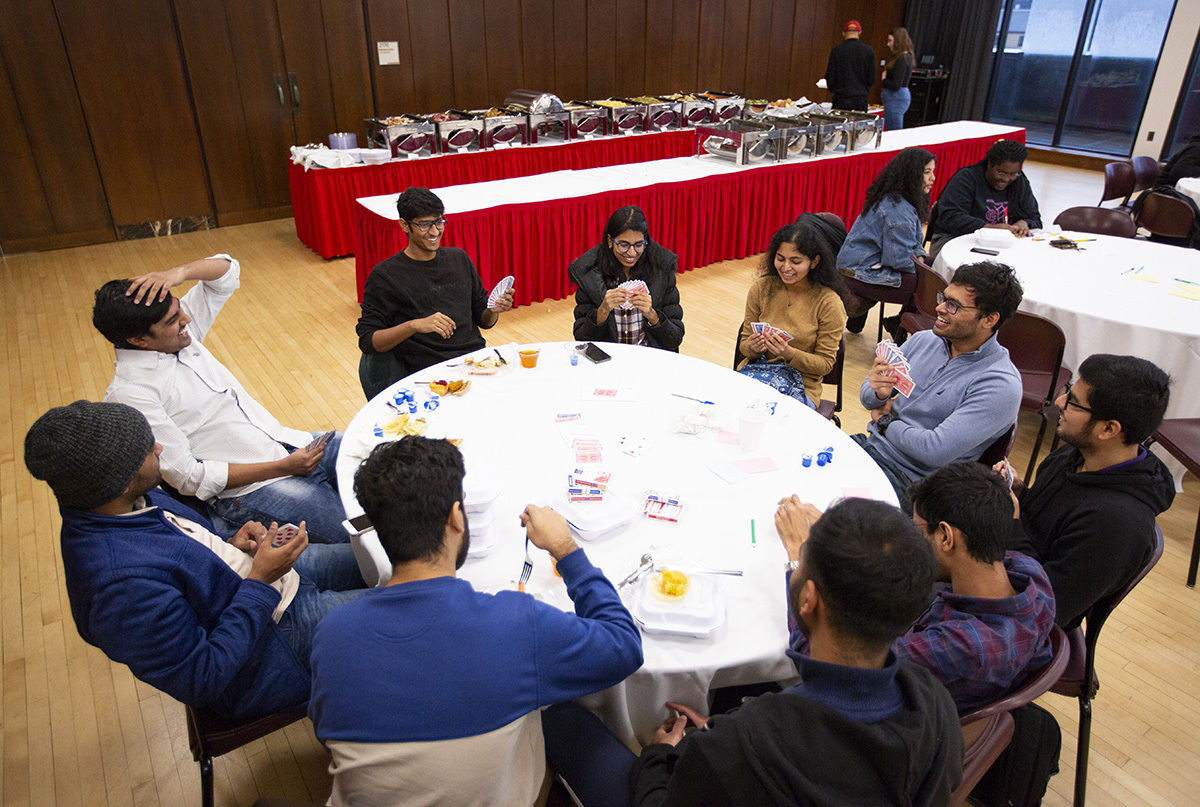
A tableful of guests enjoy card games after eating at a free community meal Nov. 26 in the Memorial Union Sun Room. Photo by Christopher Gannon.
Fall break wasn't a festive time for students like Masoud Salehi and Ali Tehrani, for a variety of reasons.
As doctoral students, they were grateful for a chance to concentrate on their research. As natives of Iran who remained on campus while many faculty, staff and students were spending time with family, their offices got lonely -- a common year-round lament for international students that's heightened when the university is out of session.
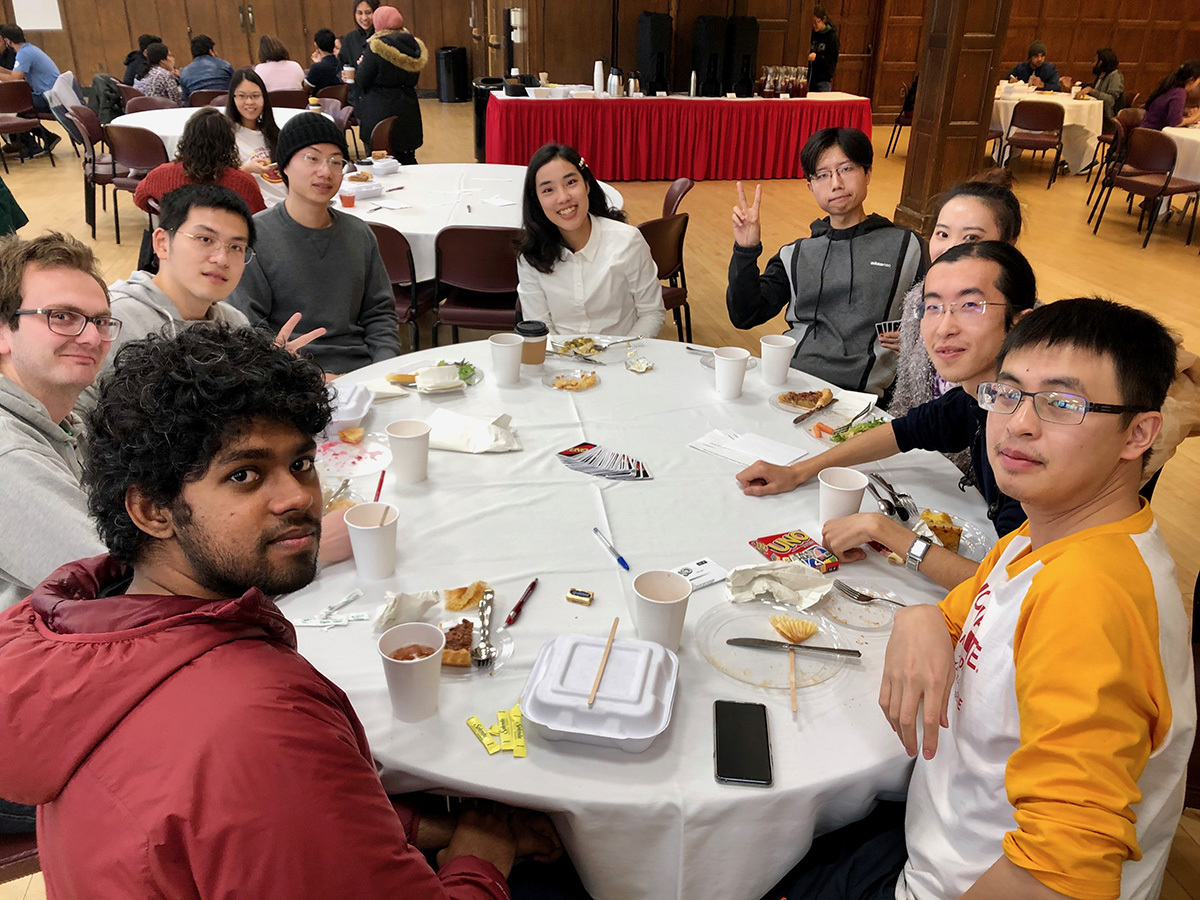
Students relaxing after the annual community dinner Nov. 26. Photo by Navya Mannengi.
An annual community dinner held before Thanksgiving makes the break week a little less solitary for students still on campus. The 2014 inaugural event welcomed just a few dozen students at the Sloss House. It has grown quickly since, with this year's version drawing more than 450 students to the Memorial Union Sun Room on Nov. 26.
The free dinner is open to anyone but is especially important for international and multicultural students, said Navya Mannengi, orientation and engagement coordinator for the international students and scholars office (ISSO).
"It shows them we have a community here that they're part of," she said.
That's how Salehi and Tehrani felt after their first taste of a traditional Thanksgiving spread that included turkey, ham, stuffing, macaroni and cheese, green bean casserole, mashed potatoes and pie. They struck up a post-dinner Uno card game with a pair of students from Bangladesh.
"We're making new friends," said Salehi, a doctoral student in business administration.
"I wish we had more times like this," said Tehrani, a doctoral student in computer science.
ISSO and college multicultural liaison officers co-host the four-hour dinner, which features a buffet followed by games and conversation. Organizers ask students about their holiday traditions in the RSVP, some of which they try to incorporate, said Elizabeth Martínez-Podolsky, multicultural student success director for the College of Agriculture and Life Sciences. The music, for example, was an ISSO-assembled Spotify playlist.
"Some of those things make it a little more like home," Martínez-Podolsky said.
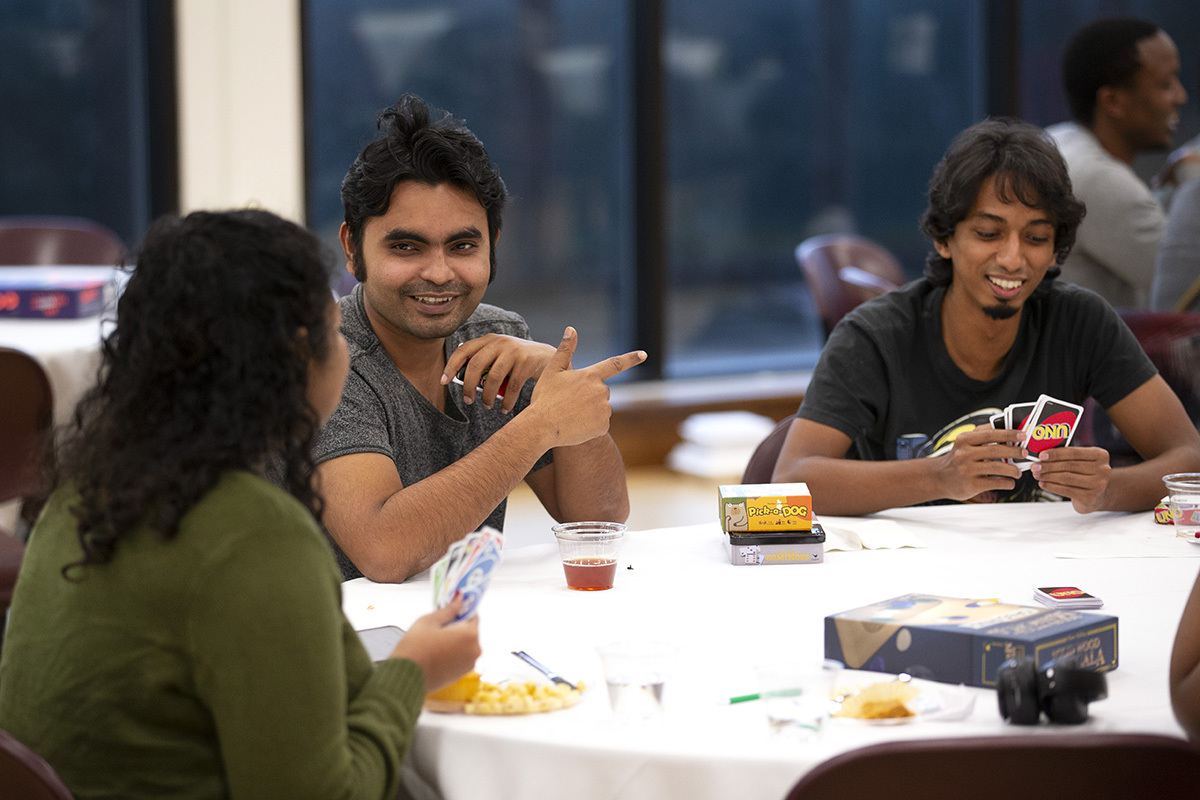
Asif Khan, second from left, a graduate student in landscape architecture and urban design, and Sakhawat Saimon, right, a graduate student in computer science, enjoy after-dinner card games. Photo by Christopher Gannon.
Beyond the organizing sponsors, the event gets support from the International Nest, the LAS International Student Network and ISU Dining. Earlier years sometimes included more diverse dishes before organizers settled on American Thanksgiving standards, which international students often are enthusiastic to try.
Sakhawat Saimon, one of the Bangladeshi students playing Uno, said while the food was more bland -- and the vibe less chaotic -- than at festivals back home, he enjoyed exploring other flavors and meeting more people.
"It's about getting to know new things. We have to accept the differences," said Saimon, a doctoral student in computer science.
Students test communication skills at Science with Cy
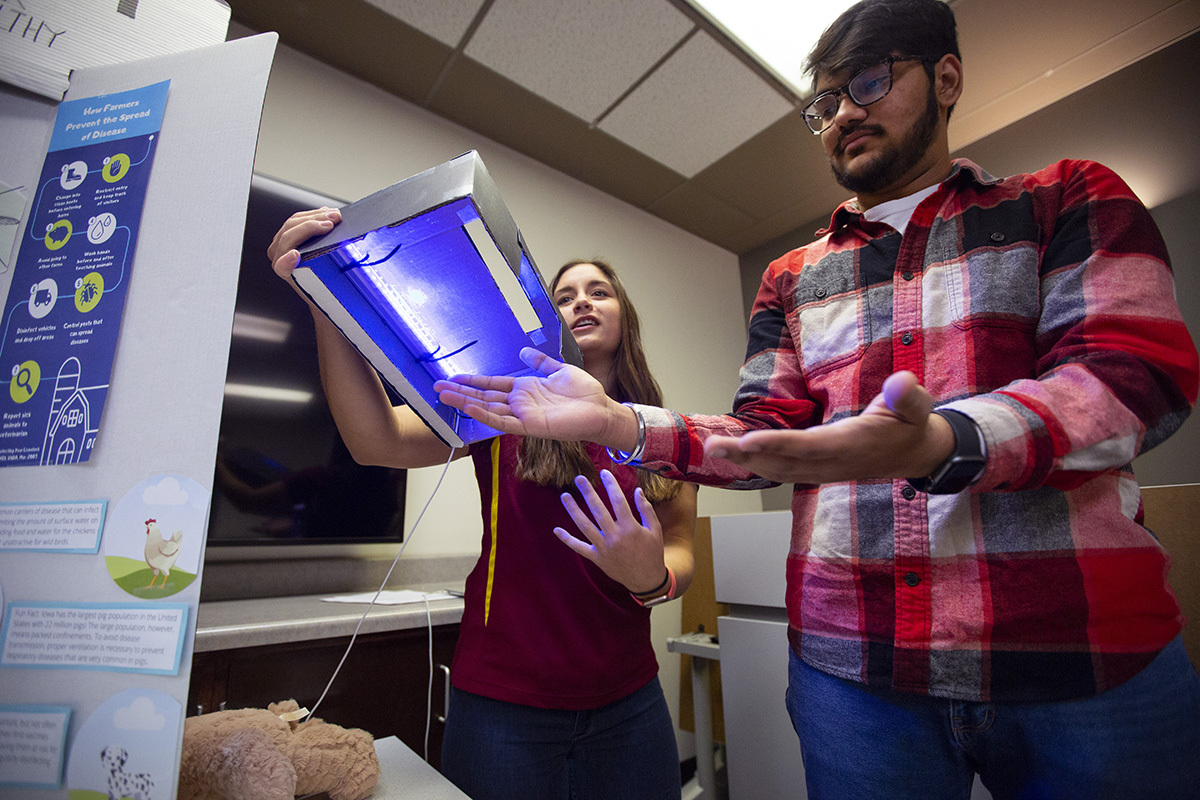
Kayla Elmore, left, uses an ultraviolet light to detect a biosecurity hazard on the hands of classmate Vishesh Bhatia during a presentation in class. The presentation will be a part of the upcoming "Science with Cy" event at the Ames Public Library. Photos by Christopher Gannon.
Science with Cy presentations
- Biosecurity: How to keep yourself and animals healthy
- Blood: How blood is a lot like your favorite superhero
- Fire Ecology: Why fire isn't always a "villain"
- Heredity: What you're made of, including traits like eye and hair color
- Microbes: How creepy-crawly microorganisms become world travelers
- Superconductors: How to make magnets float in air
- Social animal behavior: How to communicate like an animal
- Coral reefs: The many wonders of the world's coral reefs
Final exams are little more than a week away, but for students in an English 312 Biological Communications section, their biggest test may come Saturday.
Twenty-two science majors will attempt to explain topics within their fields in interesting ways to youth and their families during the inaugural "Science with Cy" event at the Ames Public Library. Presenting a project to their peers is nothing new for many of these students, but trying to get -- and keep -- the attention of a young audience for five to seven minutes can elicit a completely different feeling.
"It is 50-50," said Vishesh Bhatia, a senior genetics major. "It is exciting because at the end of the day you get to teach young individuals who are going to be the future of this country. The nerve-wracking part is making sure they understand it all. That is always the hardest."
Knowing the audience
The eight presentations, designed for middle schoolers, are the first for most of the ISU students, and they want to avoid using too many technical terms while keeping it fun. That will be accomplished through interactive elements that draw in the audience. A fire tornado, liquid nitrogen and ultraviolet light are some of the things that will be used to explain and educate. Scientist Cy, the event's headliner, also will be there.
To prepare, each presentation group practiced in front of their classmates and graduate students, receiving feedback and adjusting accordingly.
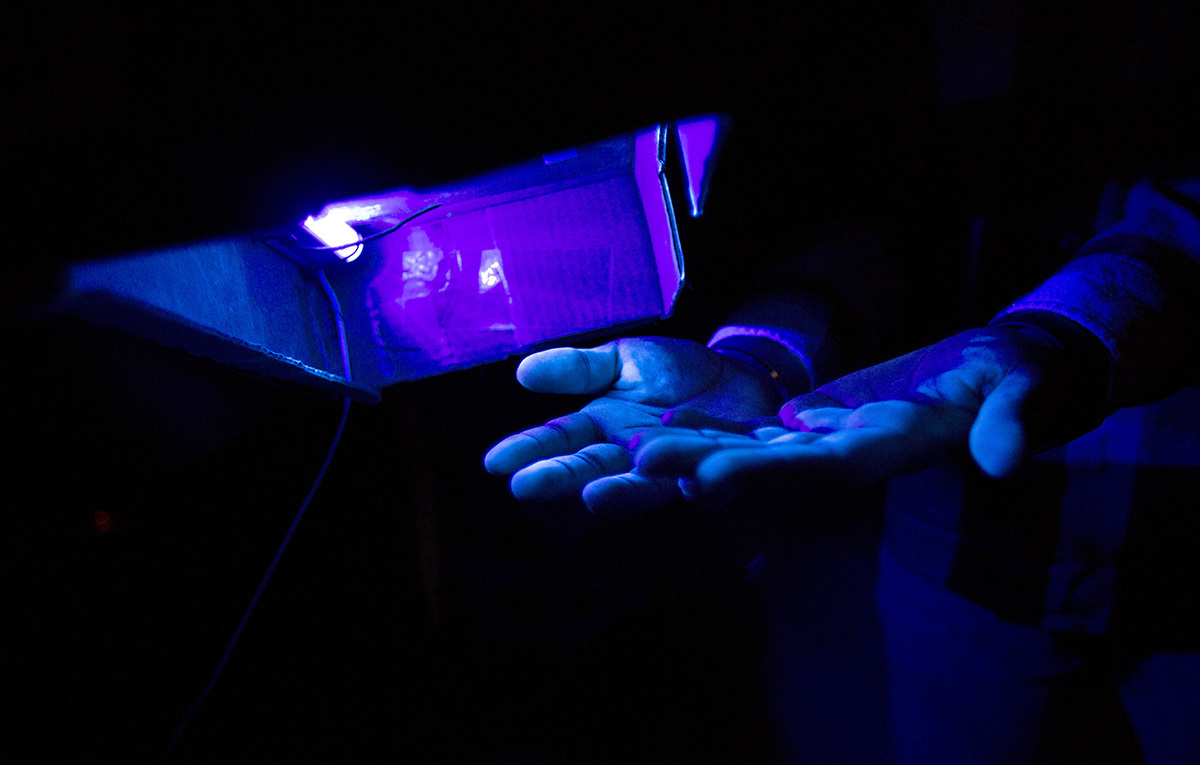
Kayla Elmore, left, uses an ultraviolet light to detect a biosecurity hazard on the hands of classmate Vishesh Bhatia.
"Constructive feedback is always helpful," said Bhatia, who will present on heredity and genetics. "This is about Iowa State's message of reaching out to a bigger audience, and not just limiting ourselves to ISU students. This is part of going out in the community, serving the community and educating the community."
Bhatia hopes to inspire those in attendance to think of science in a different way.
Larger meaning
Emma Murray, lecturer in English, came up with the idea of Science with Cy as part of an effort by the department to find new ways to engage students. The class is one of a series of advanced communication courses in ISUComm, which emphasizes written, oral, visual and electronic communication competencies.
If you go
What: Science with Cy
When: 2-3:30 p.m., Dec. 7
Where: Farwell T. Brown Auditorium, Ames Public Library, 515 Douglas Ave.
Cost: Free
"We are trying to put together a standard curriculum that will work for all sections," said Jenny Aune, associate teaching professor in English and director of ISUComm advanced communication. "All of the current instructors are trying new things to see what students react to and like. Emma came on this idea of reaching multiple levels of audience while maintaining the accuracy of the original ideas, but you have to change the frame and narrative for the audience you are working with."
Aune hopes science fairs become part of the class each semester. One section is participating this semester, but the practice could expand to all sections in the spring.
The presentations put students in situations that may be uncomfortable, but Aune said it often leads to improved confidence in an area many students underestimate themselves. Communication skills -- and the ability to use them effectively regardless of audience -- will benefit the students throughout their careers.
"In advanced communication, we are always telling them to imagine you are writing to a certain audience," Aune said. "But that whole 'imagine' thing is hard to do. Not everyone can envision all of what the audience believes and what their needs are."
This puts the students front and center with a fun twist.
What to do about spam calls? Let it go.
Your office phone rings and an unfamiliar number appears on the caller ID screen, perhaps with a 515 or 641 area code. Answering the apparently Iowa-based call is understandable.
Yet often it's an "exciting offer" to reduce student loan debt, a "friendly reminder" about an expiring vehicle warranty or a "helpful warning" about criminal activity linked to your social security number. They're obvious scams, and the phone keeps ringing.
"It is a frustration, and a nuisance," said Korine Spengler, manager of the information technology services (ITS) communication and collaboration team that oversees voice call and videoconferencing services.
So, how should you handle spam phone calls? There is no quick and easy solution to stop them, but here are five things to know if you're getting relentless robocalls at the office.
Let it go
There is nothing wrong with letting an off-campus call to your university phone go to voicemail. If you don't recognize the number and have been receiving spam calls, it's what you should be doing. Not answering is the best tactic for dealing with the interruption of illegitimate phone calls, Spengler said.
Hang up ASAP
As soon as you know a phone call is illegitimate or unwanted, end it immediately. It's often easy to tell if it's a fraud attempt or a sales pitch. There is no need to say anything before hanging up, as there's nothing to be gained by engaging, Spengler said. Never provide personal information to a stranger on the phone.
Difficult to trace
Spoofing, the technology that tricks caller ID, makes tracking the source of illegal calls difficult. While the federal Do Not Call list and its fines worked to limit phone solicitations made by human telemarketers, it's not an effective deterrent for would-be fraudsters who can blast seemingly local robocalls on the cheap from anywhere.
Monitoring traffic
The ITS communication and collaboration team does monitor overall phone traffic volume for major spam call attacks and works to block or reroute them. They're relatively common, occurring every couple weeks on average, Spengler said. Sometimes, team members will call an offending number to try to talk to someone on the other end. "We don't want to block anyone who has a legitimate reason for calling campus," she said.
Added protection
Some ISU employees can't ignore phone calls, of course. If spam calls become a problem at call centers or the main numbers for departments, colleges and units, adding an automated attendant (press 1 to speak with a ...) is an option, Spengler said. "There is a cost, but it is something that we've done for some departments," she said. It's also available for individual office phones.
'Anon(ymous)' offers modern twist on Greek classic
Panel discussion
A panel discussion following the final performance is planned as part of ISU Theatre's year-long symposium series. Community members are invited to enjoy refreshments and engage in a roundtable discussion with local, regional and national artists and scholars.
"An Unending Odyssey: Immigration, Intersectionality and the Arts"
Sunday, Dec. 8, 3 p.m.
004 Scheman Building
Refugees are the larger-than-life heroes in ISU Theatre's "Anon(ymous)" -- a poetic and action-packed retelling of Homer's "The Odyssey." Opening Dec. 6 in Fisher Theater, the classic Greek drama is reimagined as a young refugee's epic search for his family in the United States.
Arpita Mukherjee, artistic director of the New York-based Hypokrit Theatre Company, is guest directing the production as the College of Liberal Arts and Sciences (LAS) Dean's artist-in-residence.
"It's been a joy and privilege to be the LAS Dean's artist-in-residence," Mukherjee said. "ISU Theatre is cultivating the citizen artists of the future, with the key word being citizen. These young citizen artists are dynamic, fierce and bright. Collaborating with them, listening to them and learning from them has been an extraordinary experience and has fortified my belief that they are the answer to the great challenges we face today."
Written by playwright Naomi lizuka, "Anon(ymous)" follows Anon on a desperate search for his mother, from vast oceans to urban realities. Along the way, he meets new friends and dangerous foes.
"In 2018, 70.8 million people were forcefully displaced around the world -- that's 37,000 people per day," Mukherjee said. "These stories are one of the most vital stories of the world and yet rarely seen on the American stage. Here, the refugees are the larger-than-life heroes, and we watch them not just survive, but thrive."
Senior Olly Manning mastered physically demanding choreography involving somersaults and fist fighting to play the role of Anon. Manning hopes the show's exploration of refugee stories and xenophobia will ignite understanding and empathy.
"I hope audiences can see their experiences highlighted in this show, be it the refugee experiences, shared trauma, friendship or the sweet reminders of home," Manning said. "I hope that if the audience doesn't see a little bit of themselves in this show, they learn about what other people go through in America."
While "Anon(ymous)" represents the stories of immigrants, Manning emphasized that working with the production's diverse team has been a powerful personal experience.
"Being cast as a lead as a transgender actor, especially as a trans actor of color, is something I never thought would happen to me," Manning said. "Representation is incredibly important for us, given that we're routinely erased, caricatured or replaced. I hope younger kids like us out in the community see that they can achieve their goals in the 'real' world."
"Anon(ymous)" performances are at 7:30 p.m. on Dec. 6, 7, 12, 13 and 14, and at 1 p.m. on Dec. 8. Tickets ($20 for adults, $18 for seniors and $10 for students) are available through the Stephens Auditorium ticket office, Ticketmaster or at Fisher Theater ticket office prior to the performances.
